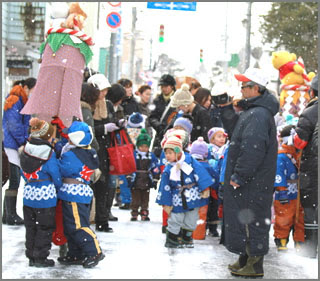. Kanai anzen 家内安全 "peace at home" .
:::::::::::::::::::::::::::::::::::::::::::::::::::::::::::::::::::::::::::::::::::::::::::::::::::::
| Bondeko ぼんでこ fertility stick  from Yokote, Akita. This stick is also called yome tataki 嫁叩き "hitting the bride" shuugiboo, shuugi boo 祝儀棒 "festival stick" bondekoboo, bondeko boo ぼんでこ棒 iwaiboo, iwai boo 祝い棒 "festival stick" bontenko ぼんてんこ Bontenko It is used to induce fertility, either in the bride of a home or for the fields. The thicker parts are made from special cuttings and shavings of wood. The use of this stick is very old in the Yokote region. It was sold on the first festival for the deity Bonten, hence the name.  Bonten Hoonoo Sai 梵天奉納祭 Festival dedicated to Bonten 三所神社梵天奉納祭 at the shrine Sanjo Jinja 三所神社. . Bonden Festival in Akita 梵天祭り. ::::::::::::::::::::::::::::::::::::::::::::::::::::::::::::::::::::::::::::::::::::::::::::::::::::: Bonten Sticks ぼんてん sticks to represent Bonten  The Bonten Festival is held at the shrine Asaoka Jinja 旭岡神社 on February 17 (it used to be the 17th of the first lunar month) and has a history of more than 250 years. In the local dialect, it is called "Bonden matsuri". bonden is a form of a ritual wand (gohei 御幣) for Shinto ceremonies (and thus not related to the deity Bonten, this mix-up came later). On the day before the festival, there is a parade through town with a concours to win the most spectacular bonden. Groups from all wards of the city and groups of craftsmen and businessmen compete with their bonden. Young men blow the conch and shout: joyasa joyasa ジョヤサ、ジョヤサ. They carry the bonden and balance it on a strap around their bodies, swinging it high in the air before the shrine hall, before offering it to the deity. The bondeko boo ぼんでこ棒(祝儀棒)  is in fact not related to the above festival, but for some reason has now been sold in stalls too. This ceremonial stick is only about 40 cm long and made from white wood of willows or a local tree called koshiabura (Acanthopanax sciadophylloides). The wood is cut in a special way to produce shavings for the thicker parts (kezurikake shijimu 削り掛け縮). This iwaiboo has been used in many parts of Japan in rituals to pray for children (kodakara 子宝) and a good harvest. source : 民芸館 . . . CLICK here for Photos of Asakoa shrine ! :::::::::::::::::::::::::::::::::::::::::::::::::::::::::::::::::::::::::::::::::::::::::::::::::::::  source : gangu akita ::::::::::::::::::::::::::::::::::::::::::::::::::::::::::::::::::::::::::::::::::::::::::::::::::::: observance kigo for the New Year yome tataki 嫁叩 よめたたき, 嫁たたき hitting the new bride ..... yome tsutsuki 嫁つつき(よめつつき)、okatabuchi 御方打(おかたぶち) ..... harame uchi 孕め打(はらめうち, はらみ節供 Hitting the young bride on the bottom with a lucky wand, wishing for a pregnancy. mizu iwai 水祝, 水祝い, みずいわい sprinkling the new couple with water ..... mizukake iwai 水掛祝(みずかけいわい) ..... mizu abise 水浴せ(みずあびせ) .....mizukake burumai 水掛振舞(みずかけぶるまい) January 14 . WKD : The New Year . ................................................................................. kayuzue 粥杖 (かゆづえ) "rice gruel stick" ..... kayu no ki 粥の木(かゆのき) ..... kayuki 粥木(かゆき) fukuzue 福杖(ふくづえ)lucky stick ..... iwai boo、祝棒(いわいぼう)"festival stick" This stick was used to stir the rice gruel for January 15 celebrations. It could be used to hit a woman on her behind with the wish for fertility, when this stick was symbolizing the male organ. The custom is still practised in some rural mountain areas. . Rice gruel and KIGO shoofuku boo 招福棒 stick to bring good luck . Folk Toys from Gifu . ::::::::::::::::::::::::::::::::::::::::::::::::::::::::::::::::::::::::::::::::::::::::::::::::::::: . Reference . ::::::::::::::::::::::::::::::::::::::::::::::::::::::::::::::::::::::::::::::::::::::::::::::::::::: fertility needed to rebuild Tohoku - bondeko stick . Japan after the BIG earthquake March 11, 2011 |
:::::::::::::::::::::::::::::::::::::::::::::::::::::::::::::::::::::::::::::::::::::::::::::::::::::
. Nakayama ningyoo 中山人形 Dolls from Nakayama
Nakayama no kushi ko anesama 中山の串コ姉様
elder sister dolls on a stick, sold at the Bonden Festival
. Folk Toys from Akita .
[ . BACK to WORLDKIGO . TOP . ]
[ . BACK to DARUMA MUSEUM TOP . ]
:::::::::::::::::::::::::::::::::::::::::::::::::::::::::::::::::::::::::::::::::::::::::::::::::::::

No comments:
Post a Comment